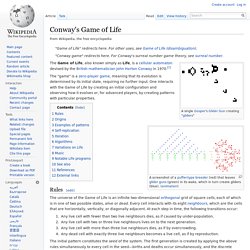

Free tutorials on HTML, CSS and PHP - Build your own website - HTML.net. Conway's Game of Life. "Conway game" redirects here.

For Conway's surreal number game theory, see surreal number. The Game of Life, also known simply as Life, is a cellular automaton devised by the British mathematician John Horton Conway in 1970.[1] The "game" is a zero-player game, meaning that its evolution is determined by its initial state, requiring no further input. One interacts with the Game of Life by creating an initial configuration and observing how it evolves or, for advanced players, by creating patterns with particular properties.
Rules[edit] The universe of the Game of Life is an infinite two-dimensional orthogonal grid of square cells, each of which is in one of two possible states, alive or dead. The initial pattern constitutes the seed of the system. Origins[edit] The game made Conway instantly famous, but it also opened up a whole new field of mathematical research, the field of cellular automata ... Conway chose his rules carefully, after considerable experimentation, to meet these criteria: Don't repeat yourself. Applying DRY[edit] DRY vs WET solutions[edit] Violations of DRY are typically referred to as WET solutions, which is commonly taken to stand for either "write everything twice" or "we enjoy typing".[2][3] See also[edit] References[edit] External links[edit]

You aren't gonna need it. "You aren't gonna need it"[1][2] (acronym: YAGNI)[3] is a principle of extreme programming (XP) that states a programmer should not add functionality until deemed necessary.[4] Ron Jeffries writes, "Always implement things when you actually need them, never when you just foresee that you need them.

"[5] The phrase also appears altered as, "You aren't going to need it"[6][7] or sometimes phrased as, "You ain't gonna need it". YAGNI is a principle behind the XP practice of "do the simplest thing that could possibly work" (DTSTTCPW).[2][3] It is meant to be used in combination with several other practices, such as continuous refactoring, continuous automated unit testing and continuous integration.
Used without continuous refactoring, it could lead to messy code and massive rework. Continuous refactoring in turn relies on automated unit tests and/or static analysis tools as a safety net and continuous integration to prevent wider integration problems. Certifications. HTML Marquee Code. CSS Marquee CSS marquees are the standards-compliant way of creating marquees in HTML.

More CSS Marquees Bootstrap Carousel The Bootstrap carousel is also standards-compliant, as it is basically a Bootstrap version of a CSS marquee. Get Code. CSS Color Module Level 3. Abstract CSS (Cascading Style Sheets) is a language for describing the rendering of HTML and XML documents on screen, on paper, in speech, etc.

It uses color-related properties and values to color the text, backgrounds, borders, and other parts of elements in a document. This specification describes color values and properties for foreground color and group opacity. These include properties and values from CSS level 2 and new values. Status of this document This section describes the status of this document at the time of its publication. The (archived) public mailing list www-style@w3.org (see instructions) is preferred for discussion of this specification. This document was produced by the CSS Working Group (part of the Style Activity). A separate implementation report contains a test suite and shows that each test in the test suite was passed by at least two independent implementations.
A complete list of changes to this document is available. Table of Contents 1. 2. 3. 3.1. Example(s): COMPUTER SCIENCE.
MIT 6.00 Introduction to Computer Science and Programming, Fall 2008. What If? - Getting Started with Programming. Apps for good. Windows phone and xbox live indie games development. Your Life is an Algorithm, Your Brain is an Operating System. Ever wondered how you were supposed to keep up with the never-ending stream of content and data in your life?

Not to worry, the elves of the Internet are busy at work, creating everything from magical little algorithms that automatically execute basic tasks to sophisticated utility apps that run in the background, taking care of all the minutiae in your daily life. Forget about hiring a personal assistant, you can “hire” off-the-shelf algorithms and digital apps that do all the heavy lifting for you. If that doesn't work, just ask Siri. Your life is an algorithm, your brain is an operating system, now go get some sleep. One of these digital algorithms that is attracting the most buzz is ifttt, which is shorthand for “if this, then that.” We are entering a new era where the algorithm rules. Taking a bigger picture view, the Web is moving away from just curating content, to actually performing artificial intelligence operations on that content.